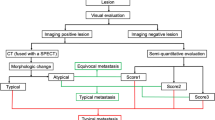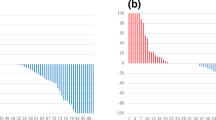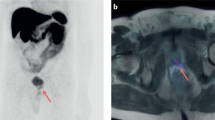Abstract
Background:
Understanding the mechanisms driving disease progression is fundamental to identifying new therapeutic targets for the treatment of men with metastatic castration-resistant prostate cancer (mCRPC). Owing to the prevalence of bone metastases in mCRPC, obtaining sufficient tumor tissue for analysis has historically been a challenge. In this exploratory analysis, we evaluated imaging, procedural and clinical variables associated with tumor yield on image-guided bone biopsy in men with mCRPC.
Methods:
Clinical data were collected prospectively from men with mCRPC enrolled on a phase II trial with serial metastasis biopsies performed according to standard clinical protocol. Imaging was retrospectively reviewed. We evaluated the percent positive biopsy cores (PPC), calculated as the number of positive cores divided by the total number of cores collected per biopsy.
Results:
Twenty-nine men had 39 bone biopsies. Seventy-seven percent of bone biopsies had at least one positive biopsy core. We determined that lesion size and distance from the skin to the lesion edge correlated with tumor yield on biopsy (median PPC 75% versus 42% for lesions >8.8 cm3 versus ⩽8.8 cm3, respectively, P=0.05; median PPC 33% versus 71% for distance ⩾6.1 versus <6.1 cm, respectively, P=0.02). There was a trend towards increased tumor yield in patients with increased uptake on radionuclide bone scan, higher calcium levels and shorter duration of osteoclast-targeting therapy, although this was not statistically significant. Ten men had 14 soft tissue biopsies. All soft tissue biopsies had at least one positive biopsy core.
Conclusions:
This exploratory analysis suggests that there are imaging, procedural and clinical variables that have an impact on image-guided bone biopsy yield. In order to maximize harvest of prostate cancer tissue, we have incorporated a prospective analysis of the metrics described here as part of a multi-institutional project aiming to use the molecular characterization of mCRPC tumors to direct individual therapy.
This is a preview of subscription content, access via your institution
Access options
Subscribe to this journal
Receive 4 print issues and online access
$259.00 per year
only $64.75 per issue
Buy this article
- Purchase on Springer Link
- Instant access to full article PDF
Prices may be subject to local taxes which are calculated during checkout


Similar content being viewed by others
References
Siegel R, Naishadham D, Jemal A . Cancer statistics, 2013. CA Cancer J Clin 2013; 63: 11–30.
Wu JS, Goldsmith JD, Horwich PJ, Shetty SK, Hochman MG . Bone and soft-tissue lesions: what factors affect diagnostic yield of image-guided core-needle biopsy? Radiology 2008; 248: 962–970.
Chua DT, Ackermann W, Veenema RJ . Bone marrow biopsy in patients with carcinoma of the prostate. J Urol 1969; 102: 602–606.
Mehan DJ, Broun GO Jr, Hoover B, Storey G . Bone marrow findings in carcinoma of the prostate. J Urol 1966; 95: 241–244.
Spiers AS, Deal DR, Kasimis BS, Miller BR . Evaluation of the bones and bone marrow in patients with metastatic carcinoma of the prostate: radiologic, cytologic and cytogenetic findings. J Med 1982; 13: 303–307.
Sy FA, Gursel EO, Veenema RJ . Positive random iliac bone biopsy in advanced prostatic cancer. Urology 1973; 2: 125–127.
Ross RW, Halabi S, Ou SS, Rajeshkumar BR, Woda BA, Vogelzang NJ et al. Predictors of prostate cancer tissue acquisition by an undirected core bone marrow biopsy in metastatic castration-resistant prostate cancer—a Cancer and Leukemia Group B study. Clin Cancer Res 2005; 11: 8109–8113.
Spritzer CE, Afonso PD, Vinson EN, Turnbull JD, Morris KK, Foye A et al. Bone marrow biopsy: RNA isolation with expression profiling in men with metastatic castration-resistant prostate cancer-factors affecting diagnostic success. Radiology 2013; 269: 816–823.
Eisenhauer EA, Therasse P, Bogaerts J, Schwartz LH, Sargent D, Ford R et al. New response evaluation criteria in solid tumours: revised RECIST guideline (version 1.1). Eur J Cancer 2009; 45: 228–247.
Scher HI, Halabi S, Tannock I, Morris M, Sternberg CN, Carducci MA et al. Design and end points of clinical trials for patients with progressive prostate cancer and castrate levels of testosterone: recommendations of the Prostate Cancer Clinical Trials Working Group. J Clin Oncol 2008; 26: 1148–1159.
Brugieres P, Revel MP, Dumas JL, Heran F, Voisin MC, Gaston A . CT-guided vertebral biopsy. A report of 89 cases. J Neuroradiol 1991; 18: 351–359.
Ghelman B, Lospinuso MF, Levine DB, O'Leary PF, Burke SW . Percutaneous computed-tomography-guided biopsy of the thoracic and lumbar spine. Spine 1991; 16: 736–739.
Lis E, Bilsky MH, Pisinski L, Boland P, Healey JH, O'Malley B et al. Percutaneous CT-guided biopsy of osseous lesion of the spine in patients with known or suspected malignancy. AJNR Am J Neuroradiol 2004; 25: 1583–1588.
Stoker DJ, Kissin CM . Percutaneous vertebral biopsy: a review of 135 cases. Clin Radiol 1985; 36: 569–577.
Boyle WJ, Simonet WS, Lacey DL . Osteoclast differentiation and activation. Nature 2003; 423: 337–342.
Acknowledgements
The clinical trial described in this manuscript was funded by Janssen. GlaxoSmithKline provided dutasteride for this trial. The cost of the tumor biopsies was funded through the Fairweather Family Fund and the Prostate Cancer Foundation Challenge Award.
Author information
Authors and Affiliations
Corresponding author
Ethics declarations
Competing interests
Dr Taplin has received research funding for clinical trials of abiraterone from Janssen and has an advisory role at Janssen. The remaining authors declare no conflict of interest.
Rights and permissions
About this article
Cite this article
McKay, R., Zukotynski, K., Werner, L. et al. Imaging, procedural and clinical variables associated with tumor yield on bone biopsy in metastatic castration-resistant prostate cancer. Prostate Cancer Prostatic Dis 17, 325–331 (2014). https://doi.org/10.1038/pcan.2014.28
Received:
Revised:
Accepted:
Published:
Issue Date:
DOI: https://doi.org/10.1038/pcan.2014.28
This article is cited by
-
Multiparametric bone MRI targeting aides lesion selection for CT-guided sclerotic bone biopsies in metastatic castrate resistant prostate cancer
Cancer Imaging (2023)
-
Optimising CT-guided biopsies of sclerotic bone lesions in cancer patients
European Radiology (2022)
-
Multiparametric bone MRI can improve CT-guided bone biopsy target selection in cancer patients and increase diagnostic yield and feasibility of next-generation tumour sequencing
European Radiology (2022)
-
Harnessing cell-free DNA: plasma circulating tumour DNA for liquid biopsy in genitourinary cancers
Nature Reviews Urology (2020)
-
68Ga-PSMA-PET/CT and Diffusion MRI Targeting for Cone-Beam CT-Guided Bone Biopsies of Castration-Resistant Prostate Cancer Patients
CardioVascular and Interventional Radiology (2020)



